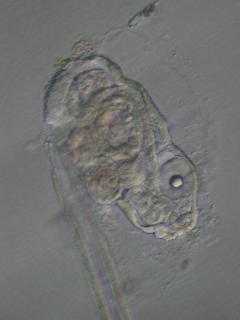Oikopleura
| Oikopleura | |
|---|---|
 | |
| Oikopleura dioica | |
| Scientific classification | |
| Kingdom: | Animalia |
| Phylum: | Chordata |
| Subphylum: | Tunicata |
| Class: | Appendicularia |
| Order: | Copelata |
| Family: | Oikopleuridae |
| Genus: | Oikopleura Lohmann, 1896 |
Oikopleura is a genus of Tunicata (sea-squirts) in the class Appendicularia. It forms a mucus house every four hours at 20 degrees Celsius. This house has a coarse mesh to keep out big particles, and a fine mesh that collects the small particles, down to the nanoplankton that includes (pelagic) bacteria.
Abandoned mucus houses sink to the deep, collecting organic particles during their descent. They make an important contribution to marine snow, since Oikopleura is abundant and is a very active filterer, using powerful strokes of its tail. Its abundance is less obvious from preserved samples (that are usually analyzed) because the gelatinous body disappears in the preservation process while leaving hardly any trace.
Species of Oikopleura have the smallest genomes in the animal kingdom, only about 75Mb.
Taxonomy
- Oikopleura (Vexillaria) Lohmann, 1933[1]
- Oikopleura (Vexillaria) albicans (Leuckart, 1853)[1]
- Oikopleura (Vexillaria) caudaornata (Fenaux & Youngbluth, 1991) [1]
- Oikopleura (Vexillaria) cophocerca (Gegenbaur, 1855)[1]
- Oikopleura (Vexillaria) dioica Fol, 1872[1]
- Oikopleura (Vexillaria) gaussica Lohmann, 1905[1]
- Oikopleura (Vexillaria) gorskyi Flood, 2000[1]
- Oikopleura (Vexillaria) inflata (Fenaux & Youngbluth, 1991)[1]
- Oikopleura (Vexillaria) labradoriensis Lohmann, 1892[1]
- Oikopleura (Vexillaria) parva Lohmann, 1896[1]
- Oikopleura (Vexillaria) rufescens Fol, 1872[1]
- Oikopleura (Vexillaria) vanhoeffeni Lohman, 1896[1]
- Oikopleura (Vexillaria) villafrancae Fenaux, 1992[1]
Distribution
The oikopleurids are distributed in the tropical waters of all oceans and seas of the globe, having been reported widely in the Caribbean Sea and the western coasts of the Atlantic Ocean.[2][3][4][5][6][7][8][9][10][11][12][13][14]
Oikopleura dioica
A species of particular interest under this genus is the Oikopleura dioica, which is an anomaly among chordates. It has retained the fundamental body plan of the chordate; yet, it has lost the mechanism for retinoic acid signaling which operates during chordate development. The loss raises the question of the evolutionary constraints that have prevented similar changes in the other chordates.[15]
Oikopleura dioica hox genes are distributed in nine locations around the genome whereas other chordates have a cluster of hox genes.[Nature 2 Sept 2004] Of note, this is the first chordate among the eukaryotes, found to have operons.[16]
References
- ↑ 1.0 1.1 1.2 1.3 1.4 1.5 1.6 1.7 1.8 1.9 1.10 1.11 1.12 1.13 1.14 1.15 1.16 1.17 1.18 1.19 World Register of Marine Species: Oikopleura Mertens, 1830 AphiaID: 103367 http://www.marinespecies.org/aphia.php?p=taxdetails&id=103367
- ↑ Flores-Coto C. 1965: Notas preliminares sobre la identificación de las apendicularias de las aguas veracruzanas. Anales del Instituto de Biología (México) 35: 293-296.
- ↑ Flores-Coto C.. 1974: Contribución al conocimiento de las apendicularias del arrecife “La Blanquilla” Veracruz, México con descripción de una nueva especie. Anales del Centro de Ciencias del Mar y Limnología, Universidad Nacional Autónoma de México 1: 41-60.
- ↑ Flores-Coto, César., Sanvicente-Añorve, Laura. & Sánchez-Ramírez, Marina. 2010: Appendicularian distribution and diversity in the southern Gulf of Mexico. Distribución y diversidad de apendicularias en el sur del golfo de México. Revista Mexicana de Biodiversidad, 81:123- 131. PDF
- ↑ Castellanos, I. A. and E. Suárez-Morales. 2009. Appendicularia (Urochordata) of the Gulf of Mexico, Pp. 1217–1221 in Felder, D.L. and D.K. Camp (eds.), Gulf of Mexico–Origins, Waters, and Biota. Biodiversity. Texas A&M Press, College Station, Texas.
- ↑ Márquez, Brightdoom., Marín, Baumar., Zoppi, Evelyn. & Moreno, Carlos. 2006: Zooplancton del Golfo De Cariaco. Bol. Inst. Oceanogr. Venezuela, Univ. Oriente. 45(1):61-78 PDF
- ↑ Zoopp, Evelyn. 1971: Apendicularias de la Región Oriental de Venezuela. Studies on the Fauna of Curaçao and other caribbean Island, 132:76-109. Lam I – VI.
- ↑ Carvalho, Pedro Freitas de. & Bonecker, Sérgio Luiz Costa. 2010: Seasonal and Spatial Variability of Appendicularian Density and Taxonomic Composition in the Caravelas Estuary (Northeastern Brazil) and Adjacent Coastal Area. Brazilian Archives of Biology and Technology, 53(1):161-169.
- ↑ Esnal G. 1972: Apendicularias de la desembocadura del Río de la Plata. Physis (Argentina) 31: 259-272.
- ↑ Esnal G. 1973: Apendicularias de las costas argentinas. Physis (Argentina) 32: 267-273.
- ↑ Esnal G. 1979: Características generales de la distribución de tunicados pelágicos del Atlántico sudoccidental, con algunas observaciones morfológicas. Physis (Argentina) 38: 91-102.
- ↑ Esnal G. 1981: Apendicularia. In: Boltovskoy (ed) Atlas del zooplancton del Atlántico sudoccidental y métodos de trabajo con el zooplancton marino: 809-820. Publicación Especial, Instituto Nacional de Investigación y Desarrollo Pesquero, Mar del Plata, Argentina. 936 pp.
- ↑ Esnal G. 1999: Appendicularia. In: Boltovskoy D (ed). South Atlantic zooplancton: 1375-1399. Backhuys Publication, Leiden, The Netherlands.
- ↑ Esnal G. & Castro, R. 1977: Distributional and biometrical study of appendicularians from the west south Atlantic. Ocean. Hydrobiologia 56:241.
- ↑ Holland, Linda Z. "Developmental biology: A chordate with a difference." Nature 447.1 (2007): 153-55.
- ↑ Blumenthal, T (2004). "Operons in eukaryotes". Briefings in Functional Genomics and Proteomics 3 (3): 199–211. doi:10.1093/bfgp/3.3.199. PMID 15642184.
External links
| Wikimedia Commons has media related to Oikopleura. |
| Wikispecies has information related to: Oikopleuridae |
- Integrated Taxonomic Information System (ITIS): Oikopleura Taxonomic Serial No.: 159668
- National Center for Biotechnologu Information (NCFI): Oikopleura Taxonomy ID: 34763
- Jellieszone: Oikopleura dioica Fol, 1872 : Larvacean
- Oikopleura Genome Browser
- Merriam-Webster: Oikopleura